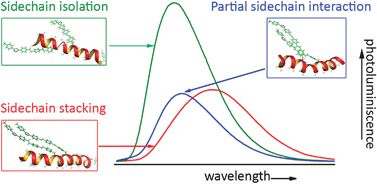Intermolecular interactions dramatically affect the structure/property relationships of electroactive molecules in device environments and have been the subject of significant research effort. Purposeful manipulation of the distance between chromophores is a key parameter in such investigations, although such manipulation has proven difficult. Systems in which distances between chromophores can be controlled serve both as model systems for understanding structure/property relationships in more depth, as well as potential active components in devices. In this work, oxadiazole-containing poly(phenylenevinylene) (Oxa-PPV) oligomers have been chemically attached in specific positions to an α-helical peptide scaffold, which permits the presentation of the Oxa-PPV side-chains at distances of nominally 6 Å and 11 Å apart on the same side and also 7 Å apart on opposite sides of the peptide. The Oxa-PPV side-chains were attached to the peptide scaffolds via straightforward Heck coupling strategies; the resulting modified peptides were characterized by a variety of spectroscopic methods. Circular dichroic spectroscopy (CD) confirmed the helical conformation of the scaffolds modified with the bulky conjugated side-chains, and suggested that side-chain interactions may improve the thermal stability of the molecules. Exciton-coupled CD measurements confirmed the interactions of the conjugated side-chains and detected subtle apparent differences in side-chain orientation that were also indicated in computational modeling of the molecules. Photoluminescence spectroscopy confirmed the electronic interaction of the side-chains; the results clearly captured differences in luminescence as a function of chromophore presentation, and further indicated differences in excited state species with differences in chromophore presentation. The observed effects indicate not only that bulky chromophores can be presented on helical peptide templates without loss of template conformation, but also that such presentation may accurately capture details of electronic transport between molecules commonly employed in organic electronic applications.

You have access to this article
 Please wait while we load your content...
Something went wrong. Try again?
Please wait while we load your content...
Something went wrong. Try again?


 Please wait while we load your content...
Please wait while we load your content...